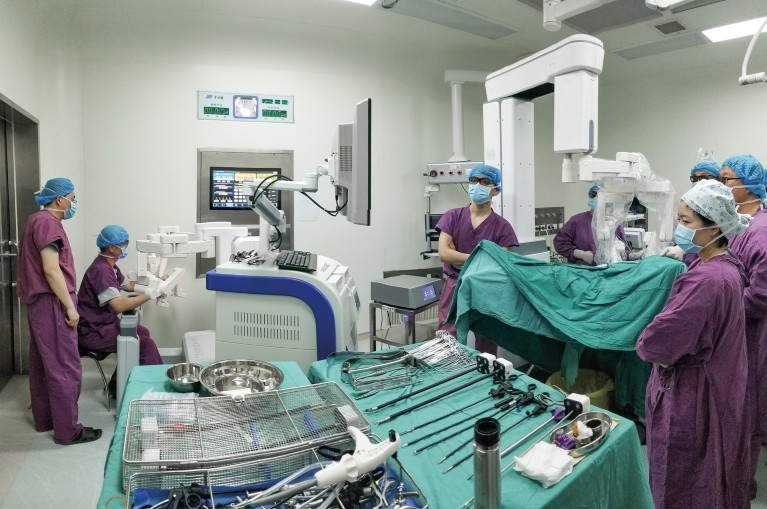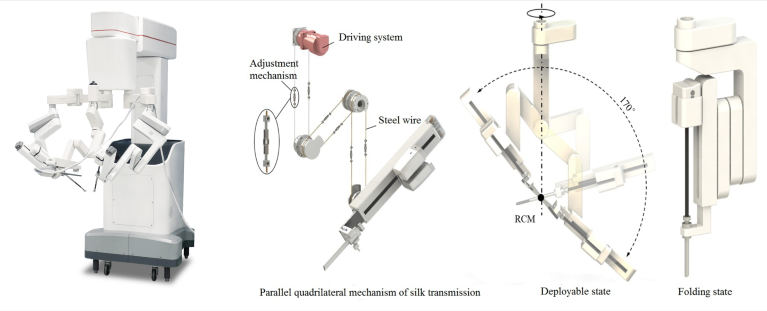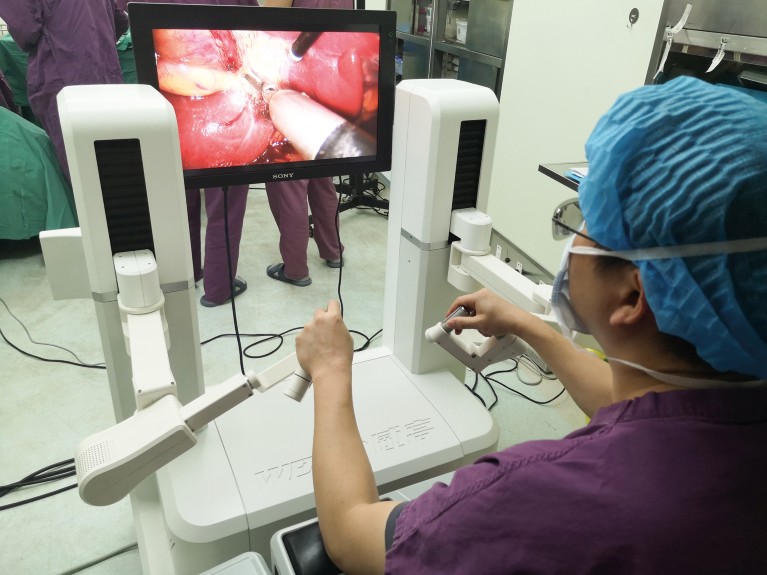
Researchers at the Third Xiangya Hospital of Central South University are making preparations to test the surgical robotic system, Micro Hand S.Credit: Third Xiangya Hospital of Central South University
Robots have been working in the manufacturing industry since the 1950s, but their entry into the realm of medicine was not until the 1990s, along with a demand for minimally invasive surgery. Since then, the growth of the robotics industry, and the emergence of artificial intelligence (AI) technology, have driven advances in robotic surgery.
In China, the demand for minimally invasive surgery has promoted research and development (R&D) into building the country’s own medical robots.
A collaborative project that started in 2008 has led to a novel robotic system for multi-incision laparoscopic surgery, expected to be available for clinical use soon.
A growing need
Robotic systems in medicine are relatively new, but advances are developing quickly. The first surgical robot can be traced back to the Automated Endoscopic System for Optimal Positioning (AESOP), which was approved for clinical use by the US Food and Drug Administration (FDA) in 1994. Essentially a robotic arm for holding an endoscope, AESOP is voice controlled, with adjustable positioning to ensure a steady view of the operating field during endoscopic surgery. Further progress with AESOP led to a master-slave robotic system, ZEUS, in 1996, developed by Computer Motion, the same US company that produced AESOP. This upgraded system has three robotic arms to perform surgical tasks, and allows for remote manipulation by surgeons.
The most popular surgical robot today is the da Vinci Surgical System, developed by the US company, Intuitive Surgical. Its three-dimensional (3D) vision system accurately captures images. With an advanced motion control system, its robotic arms can replicate what the human arm can do, with the capacity to perform more complicated surgeries. In 2000, the FDA approved the use of the da Vinci system, and it has since become the most widely used surgical robot.
The da Vinci system entered the Chinese medical market in 2008. By 2019, 112 had been installed, and used in more than 110,000 surgical operations, ranging from gastrointestinal and cardiothoracic, to hepatobiliary, urologic, and gynaecological surgeries. These robots offer clearer imaging, greater accuracy, stability, and range of motion. The ergonomic design means greater comfort for the operating surgeon, eliminating the problem of fatigue. The improved precision means smaller incisions and less pain for patients, enabling faster recovery.
However, the high cost of these imported machines limits their broad use in China, so the prevalence of robotic surgery is much lower in China than in some Western countries, as well as Japan and Korea.
The need to advance minimally invasive technologies, while lowering medical costs, has driven a major research project supported by the National Natural Science Foundation of China (Project No: 51875580), and National Key Research and Development Plan Fund (Grant No: 2017YFC0110402), to develop China’s own surgical robots. Led by Central South University, in collaboration with Tianjin University and Beihang University, the project will fill the gap in China’s development of high-end medical instruments. It is also in line with the national strategic plan to upgrade Chinese industry.
Making of a novel surgical robot
Interdisciplinary collaboration is essential to the development of surgical robots, which requires application of theories and technologies in medicine, mechanical engineering, robotics, optics, computer science and automatic control. The project has brought together interdisciplinary teams with broad experience in related key technologies and minimally invasive medicine, setting a good model for medical-engineering collaboration.
Innovations are made in improving clinical safety and effectiveness. The design of surgical robot, Micro Hand S, was informed by studies of rich clinical data from the Third Xiangya Hospital of Central South University, from which researchers can prioritise necessary and desirable features of the robot. By studying the mechanisms underlying bio-machine interface, integrating bionic techniques, mechanical and new materials technologies, the joint research team has optimized the design to address safety issues, leading to more dexterous robotic arms, and precise, real-time control.
In robotic surgeries, the lack of force feedback presents a challenge for a surgeon to maintain precise control, without damaging tissues. Researchers at the Third Xiangya Hospital of Central South University, based on their vast experience in minimally invasive surgeries, have built classified databases on physical characteristics of patients, the interaction between human soft tissues and surgical instruments, as well as operator-instrument interface. Design standards for the surgical robot were set based on careful studies of these data, which have also informed product safety and reliability evaluation systems. These guidelines have brought a design that ensures clinical safety and effectiveness, while improving usability.
Specifically, simulation evaluation studies are based on mapping instrument movement when it is in safe range, and the rapid upper limb assessment (RULA) is used to check how well mapping is performed, leading to a design that enables adjustable operation. The assessment also informs an ergonomic design where the surgeon’s palm, rather than fingers is force-bearing, improving comfort, as well as operation efficiency.
For a master-slave robotic system, where one device (the master) has a unidirectional control over the other, precision is key. Based on an intuitive motion control strategy, researchers have built a model of bilateral control, enabling simulation of control signals at the master end to ensure their accuracy before they are sent to the slave devices. Given the complexity of motion planning for such a master-slave system, special techniques were applied to decouple the control of master and slave manipulators. This enables efficient joint matching to the human arm, and precise control of surgical instruments.

Based on a model for origami of thick panels, Micro Hand S features a foldable, compact design that allows for extensive movement.Credit: Third Xiangya Hospital of Central South University
The Micro Hand S features a compact, foldable, design that allows for a wide range of possible movements by the instruments in a limited space. While origami principals are typically applied to the folding of very thin materials, such as paper, researchers from Tianjin University have developed a model for rigid origami of thick panels, capable of reproducing a folding motion identical to that of zero-thickness origami1. Using this model, instruments delivered by the robotic arm have large degrees of freedom in a small working space, and the driver and control structures of the robotic system can be made more compact. Being smaller and lighter, the robot saves space, and the time needed for installation is also reduced. The flexible single-shaft configuration can adjust positioning of instruments, so that multi-quadrant operation is possible without moving the robot, and coordination between the operator and the robotic system is made easier.
Another feature of Micro Hand S is the integration of bionics in the instrument interface design. Inspired by the carnivorous tropical pitcher plant, Nepenthes alata, whose rim has a surface with multiscale structure to allow for quick, unidirectional water transport, researchers at Beihang University proposed a novel, anti-stick solution for surgical instruments2. The self-lubricating design prevents adhesion to tissue without additional energy. The biomimetic design also drew on studies of tree frogs, known for their ability to cling to surfaces. By exploring the properties underlying enhanced friction for frogs’ foot pads, researchers have designed non-slip devices for the robotic system, achieving high friction without adding outside pressure. This ensures that the force applied by the instrument end effector is in a safe range, which is usually hard to control when force feedback is lacking.
With a 3D camera system, Micro Hand S offers on-site demonstration of minimally invasive surgery to help train less experienced surgeons.Credit: Third Xiangya Hospital of Central South University
A 3D camera system is also essential. It allows the operating surgeon to clearly identify the diseased organ or tissue, differentiating them from the linked blood vessels and nerves, to prevent excessive bleeding or nerve damage when performing resection. The robotic system also allows for on-site, real-time demonstration of minimally invasive surgery, allowing less experienced surgeons to communicate with an operating surgeon in front of a monitor screen. The visualized learning helps shorten the learning curve for mastering the technology.
Using 5G communication technology, Micro Hand S can be connected to other digital devices, which help accelerate data transmission and reduce control delay, leading to optimized telemanipulation with improved accuracy.
Based on safety and effectiveness studies at the minimally invasive surgery centre at the Third Xiangya Hospital, the surgical robotic system was updated several times. Now a prototype machine is undergoing a phase II clinical trial.
Moving from lab to theatre
The development of Micro Hand S took a patient-centred approach. It closely follows protocols for evidence-based medicine to complete in vitro studies, animal experiments, and clinical trials.
First, in vitro studies were conducted based on real-time movement tracking data for safety evaluation. Mapping of the robot motion was analysed to see how well it coordinates movement of the multiple instruments by the robotic arm. The study results suggest that the movement of the instruments at the slave end of Micro Hand S closely follows that of the surgeon’s operation at the master end, with minimal superfluous movement. Both ends operate smoothly and efficiently, showing great coordination. Compared with traditional laparoscopic surgery, the surgical robot uses less operating space, and the surgical knot it ties is firmer and tighter, showing higher efficiency and precision. Its greater flexibility and stability confer advantages over laparoscopic surgery3.
In studies, Micro Hand S was used to perform 200 surgeries on pigs, including gallbladder removal, liver lobectomy, gastroenterostomy, which makes a new connection between the stomach and the duodenum, as well as intestinal anastomosis. Using 5G technology, the project team also experimented with telemanipulation. In these animal experiments, the Chinese-designed surgical robot proved capable of performing clamping, separation, cutting, electrocautery, stitching, and knot tying, completing all the complicated procedures required for minimally invasive surgeries.
In 2014, with accreditation from the Association for the Accreditation of Human Research Protection Program, a phase-I clinical trial was conducted to test the safety and efficacy of Micro Hand S. By January 2019, 103 robotic procedures were performed in gastrointestinal, hepato-pancreato-biliary, thoracic, urologic, and gynaecological surgery. From simple surgeries, or those aimed for single disease treatment, the robot was gradually used in more complicated procedures requiring greater dexterity, such as gastrectomy plus D2 lymphadenectomy, which combines lymph node removal and gastric resection for treating advanced gastric cancer.
In a few cases when complications occurred, the surgical robot was able to perform repair procedures. These robotic surgeries take reduced installation time (a median of 20 minutes) and shorter operative time (a median of 245 minutes)4,5.
Based on animal studies and phase-I clinical trials, phase II trials were launched in late 2019, with approval from China’s National Medical Products Administration. These are prospective, randomized, single-blind trials with paralleled intervention and control groups for comparing safety and effectiveness. A total of 84 gallbladder surgeries were performed, half by Micro Hand S, and half by the da Vinci system. The main indicator for success was the rate of change into non-robotic surgeries during the operation. Operative time, bleeding levels during operation, post-operative pain, bowel function recovery time, length of hospitalization, an index for complications, and rating for robot performance by the operating surgeon, were also considered in the study. The two groups appeared to show similar results in the comparison study.
Next, the project team is planning for multi-centre, prospective, randomised trials to collect more evidence for safety and effectiveness of the domestically developed surgical robot. It looks to push forward manufacturing of the surgical robot, boosting China’s industry.
The project team plans to build a national training base to educate surgeons about the use of the surgical robot, promoting its broad use. Plans are also made to establish a clinical data centre, by collecting big data on the use of surgical robots, and using AI algorithms for analysis, to guide further upgrade of China’s surgical robot, optimizing its performance, and making it globally competitive.
The development of medical robots will also extend to systems for prosthesis, rehabilitation, psychological rehabilitation, personal care, and health monitoring, which, along with surgical robots will be the emphasis of future research focuses.


